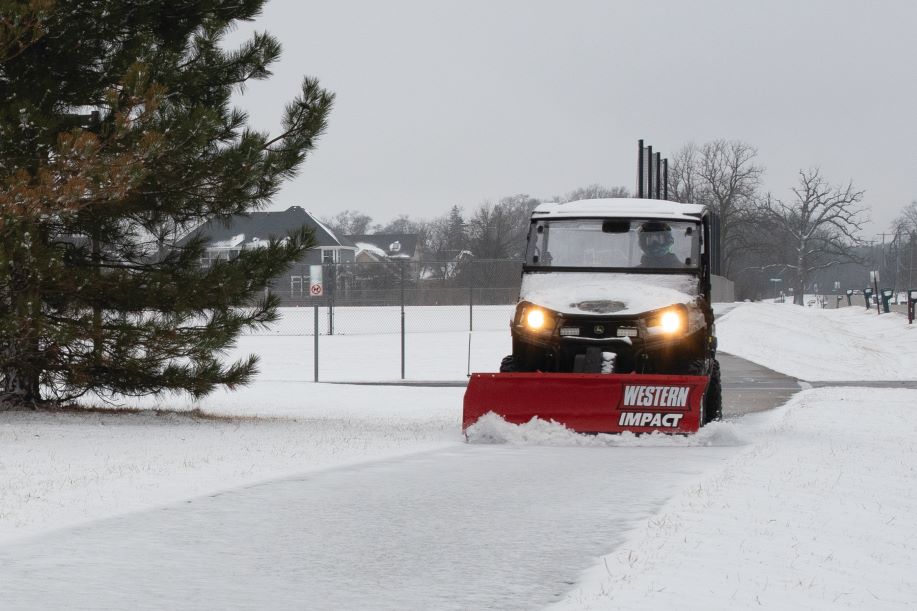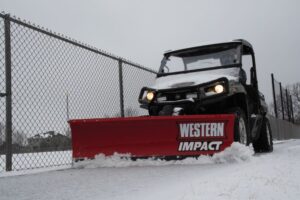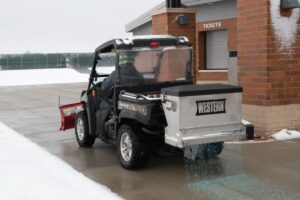Getting the Most Out of Your UTV This Winter

While work trucks equipped with plows and salt spreaders are common for roads and large parking lots; sidewalks, walking paths and driveways are increasingly being maintained by UTVs equipped with purpose-built plows and salt spreaders. To ensure your UTV is set up for snow and ice control in the winter, keep these things in mind.
Ensure you have the right attachments for your vehicle
UTVs come in a wide variety of engine sizes and vehicle weights. You need to ensure that the plow and spreader you select are right-sized for your UTV. To ensure the best match, you need to account for the weight of the attachment and the weight of the product it can carry (especially for salt/sand spreaders). The available amperage produced by the UTV is also important to ensure what type of attachment your vehicle can power.
There are several different types of UTVs available on the market:
- Mid-duty UTVs (Sport-Utility) – These vehicles provide up to 500 pounds of cargo capacity and come in 2- or 4-passenger configurations.
- Heavy-duty/full-size UTVs (Utility) – These vehicles provide up to 2,000 pounds of towing capacity and come in 2- or 4-passenger configurations
While larger UTVs can handle larger plows and spreaders, smaller UTVs can still do an excellent job with snow and ice removal. You might just have to make several passes and go slower for effective clean up.
Equip your UTV with supportive options
If you plan on using your UTV to clear snow, a windshield is important to block wind and the elements. It provides a layer of protection for the operator. Purchasing a UTV with doors and a heated cab would be a good option if you plan on using the UTV often in the winter.
Determine the type of plow you plan on using. There are manual-angle plows, winch-lift plows, and hydraulic plows. If you plan on moving a lot of snow, a hydraulic lift and angle plow could save time. Your operator can position the plow up, down, left or right without leaving the UTV cab. This is very helpful for applications that require stacking and piling. If you plan on purchasing a winch-lift plow, ensure your UTV is equipped with a winch.
Smaller charging systems, cold temps, and high electric demand make life difficult for a UTV battery. Using a high-quality sealed battery is in your best interest for snow removal. Electronic fuel injection requires sufficient voltage in order to operate. A weak or defective battery can mean more than a plow down, it can shut down the whole operation.
Snow and ice removal often happens at night or early in the morning when it’s dark. Having the correct lighting on your UTV is important. Work lights in the front and the rear of the vehicle can help illuminate the area you are clearing. The lights also make you more noticeable to other vehicles and people in the area where you are working.
Accessorize your plow for maximum efficiency and performance
Once you have decided on the best plow for your utility vehicle, you’ll want to make sure it’s set up correctly with the right accessories — including shoe kits, cutting edges, deflectors, and more.
Plow shoe kits allow you to easily adjust the height the blade from the ground. This is helpful if you are removing snow from sensitive surfaces such as gravel or pavers. You can set your shoes to allow the plow blade to float slightly above the surface to reduce damage and avoid a bulldozing effect.
The cutting edge material you use matters as well. A steel cutting edge (usually standard on most plow blades) is durable and provides a clean scrape, but it can damage sensitive surfaces such as gravel, pavers, or packed earth. Poly cutting edges are great for sensitive surfaces since the poly edge is more forgiving than steel. Poly edges might require more passes than a steel cutting edge and possibly some salt to achieve the same level of cleanup.
A rubber deflector is installed at the top of the plow blade. It limits the amount of snow that blows off the top of the blade up onto the windshield, increasing visibility and snow rolling. If you are using your UTV and plow in high-traffic areas or as a part of a sidewalk crew, a rubber deflector could increase the safety of those around the UTV.
Once your accessories are set, you need to ensure the angle of your plow is set correctly. Most plows allow you to angle left or right and lift up or down, depending on where you want your snow piles to reside. UTV plows allow you to set the angle manually, use a winch system, or use hydraulics for easy angling and lift.
Keep up with proper UTV plow maintenance
Snow removal can be demanding, so it’s important to keep up with the maintenance on your UTV. Ensure that the coolant you are using is rated to temperatures down to 40 below zero Fahrenheit. This will help keep the engine running smoothly. Know what type of oil your UTV is running. A lot of UTVs in the market today run synthetic oil, which performs well in winter conditions.
Before plowing or spreading salt or sand, ensure that all your plow and spreader connections are in place. Verifying the connections is quick, and will save you from a major issue if the connections dislodge during operation. Before making your first plow pass, coat your plow blade with oil to reduce snow sticking to the blade. Cooking oil works perfectly.
One thing to check after you move snow with your UTV is the air intake. The fine “snow dust” can freeze and make it difficult for the engine to receive the air it needs to run smoothly. Before storing your UTV, make sure you clean off everything as much as possible. This will reduce freezing and/or rusting of any exposed metal on your vehicle and snow removal tools.
When you park your UTV plow, lower the plow so it’s resting on the ground. This will alleviate the weight of the plow on your vehicle’s suspension or winch when it’s not in use. To reduce the chance of salt bridging (the salt freezing into a solid block), empty your spreader of any remaining salt after each use.
Article and photos provided by Western Products, a Douglas Dynamics brand. This article originally appeared in the October issue of SportsField Management, sister publication to Landscape Business.




